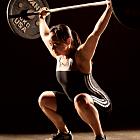 As I mentioned in Part 3 of this series, I use a different set-and-rep formula on high-skill exercises, such as the Olympic lifts—the snatch and clean and jerk—from what I do on other exercises. I also stay with lower reps on front squats. The athletes can do a couple of sets of five for warm-up attempts, but then they need to keep it to no more than three reps, and in some cases doubles are even better.
As I mentioned in Part 3 of this series, I use a different set-and-rep formula on high-skill exercises, such as the Olympic lifts—the snatch and clean and jerk—from what I do on other exercises. I also stay with lower reps on front squats. The athletes can do a couple of sets of five for warm-up attempts, but then they need to keep it to no more than three reps, and in some cases doubles are even better.
The triples or doubles allow them to pay closer attention to the various small form points of these rather complicated movements, and they can get the required work doing six or more sets, depending on their experience with the exercises.
I use threes on the front squat for a different reason. It’s not a difficult lift, and there are only a couple of key points to concentrate on—no more than the back squat, really. The big difference is that the front squat has to be racked across the front deltoids securely, and after each rep with a heavy weight the bar will slip slightly out of the ideal position. When it gets too far forward, there is a great deal of stress on the shoulders, elbows and wrists. When I see that athletes are having difficulty maintaining their rack even after the first rep, I have them lower the reps to doubles.
I do the same thing for jerks from the rack, and when lifters are doing cleans followed by jerks, I have them do three cleans and only one jerk. Over time they will improve the flexibility in their shoulders, elbows and wrists, and the rack will no longer be a problem. Still, they are better off doing no more than triples.
Another exercise on which I have my athletes stay with threes is high pulls. Most don’t think of high pulls as being a high-skill exercise, but they definitely are. In fact, the majority of athletes I start on this overloading movement have more difficulty learning to do the combination of deadlift and shrug than any other exercise in their programs.
I also deviate from the five sets of five standard for good mornings and almost-straight-legged deadlifts. I alternate these two formulas every other time they do them: four sets of 10 and five sets of eight. It may not seem that such a slight variation would make a difference, but for some reason it does. Why not just stick with fives times five? After all, both are simple movements that involve the large muscle groups.
When I first started doing good mornings, I did them for five sets of five and worked them just as heavy as I could. Then I got my hands on some Soviet training information. I noticed that they never handled more than 220 pounds on good mornings—and some of the lifters were cleaning more than 400 and snatching in the mid-three-hundreds, so why only use a meager 100 kilos for a primary back exercise?
I got the answer from a Russian coach. When athletes use more weight than 220, they are forced to alter the movement so they can maintain their balance. So when they handle a heavier weight, the focus shifts from the lumbars to the hips, and the movement is no longer specific to the lower back. I knew from my own experience with good mornings and from watching others do them that he was right. From then on I changed the sets and reps for that exercise for most of my athletes.
I say most because I still used five times five for those wanting to compete in powerlifting as well some of my larger football players because I thought that they would become more proficient in their sports if they overloaded their hips and back. All powerlifters rely on strong hips and lower backs, and football linemen can benefit from doing very heavy good mornings as well.
Editor’s note: Bill Starr was a strength and conditioning coach at Johns Hopkins University from 1989 to 2000. He’s the author of The Strongest Shall Survive—Strength Training for Football, which is available for $20 plus shipping from Home Gym Warehouse. Call (800) 447-0008, or visit www.Home-Gym.com.




















You must be logged in to post a comment Login